A Visit to St. Joseph in Nawi (on the shore of Venua Levu)
 After Mass we boarded a boat to cross the channel to Nawi, on the neighboring island of Venua Levu. Although the seas had been beautifully calm the previous few days, we had 3 to 4 foot swells today and a low pressure system. It takes an hour to travel from Matei to Nawi. Fortunately the rainstorms occurred on Taveuni after we left and were done by the time we returned. As we moved out into the ocean, Taveuni became obscured by clouds and rain.
After Mass we boarded a boat to cross the channel to Nawi, on the neighboring island of Venua Levu. Although the seas had been beautifully calm the previous few days, we had 3 to 4 foot swells today and a low pressure system. It takes an hour to travel from Matei to Nawi. Fortunately the rainstorms occurred on Taveuni after we left and were done by the time we returned. As we moved out into the ocean, Taveuni became obscured by clouds and rain.
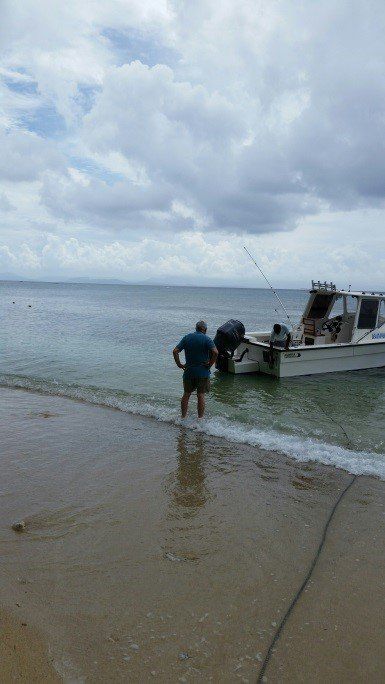 Arriving an hour later at Nawi, I had my first site of St. Joseph church which is still in use. It was clearly in disrepair and we started toward it to get a better look. We were greeted by children and by Petero, one of the adults from the village. “Bula!” we said.
Arriving an hour later at Nawi, I had my first site of St. Joseph church which is still in use. It was clearly in disrepair and we started toward it to get a better look. We were greeted by children and by Petero, one of the adults from the village. “Bula!” we said.

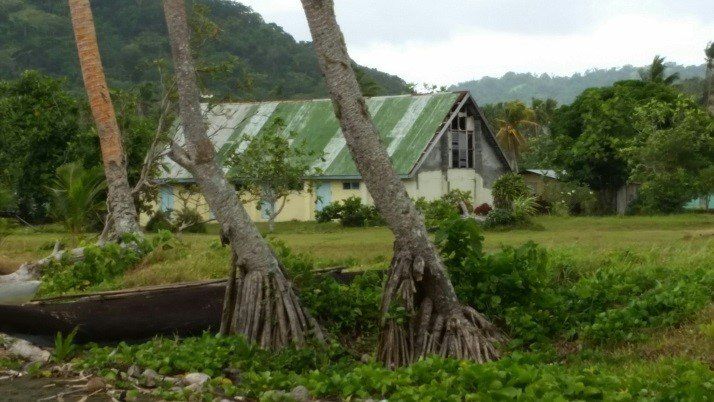
As we got to the old church the decay became more visible. Msgr. Lofton pointed out the various issues. “This building is not safe. People should not be inside. You can see why they need a new church. Most of the funds from World Missions go to the diocese for diocesan programs. You can see that this village could not possibly afford all the expenses for a new church. They need help.”
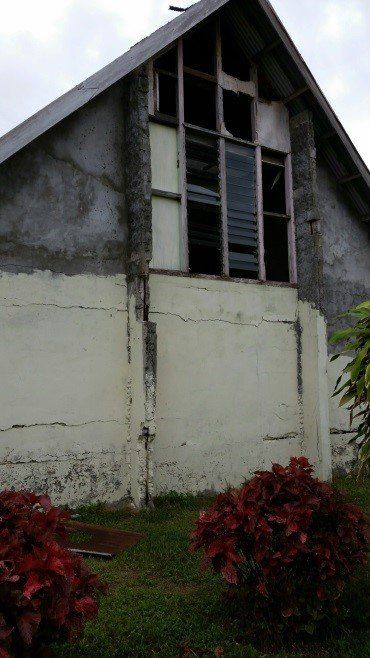 Petero said: “We are helping to build the church. I have 6 brothers and there are other men who are working on building. We wait for direction from Yava.” Yava has been a strong support for Msgr. Lofton’s efforts. He leads the design and construction for Sto. Pelasio and is doing the same for this church and for the church we visited a few days ago in Delaivuna.
Petero said: “We are helping to build the church. I have 6 brothers and there are other men who are working on building. We wait for direction from Yava.” Yava has been a strong support for Msgr. Lofton’s efforts. He leads the design and construction for Sto. Pelasio and is doing the same for this church and for the church we visited a few days ago in Delaivuna.
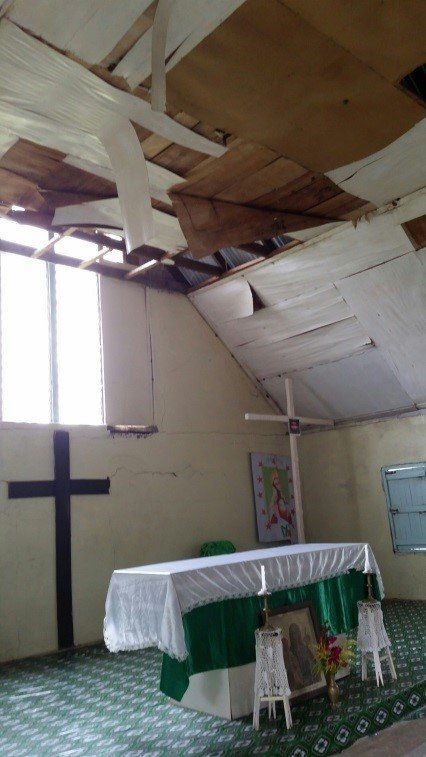 I asked Petero to look inside the church. It was disturbing to see the decay of the ceiling, which is falling down onto the altar. When I asked him why they were going through the effort to build a new church, he said “because my faith is very important to me. It is the strength for me and my family. We want a place to pray.” He said “when we come to Mass I look at the ceiling to make sure it is not falling. It doesn’t matter (I miss) what the priest is doing at the Altar.”
I asked Petero to look inside the church. It was disturbing to see the decay of the ceiling, which is falling down onto the altar. When I asked him why they were going through the effort to build a new church, he said “because my faith is very important to me. It is the strength for me and my family. We want a place to pray.” He said “when we come to Mass I look at the ceiling to make sure it is not falling. It doesn’t matter (I miss) what the priest is doing at the Altar.”
As we walked around the front of the church there was a statue of the Virgin Mary. I also had noticed a side altar in Sto. Pelasio devoted to Mary.
“What is the importance of Mary to you?” I asked.
“She is the way to Jesus,” said Petero, “she is at the front entrance because we go through Mary to get to Jesus.”
 As we started to walk toward the new building, the “Head man” of the village, whose name is Elia, came up to us and started to direct us to one of the houses.
As we started to walk toward the new building, the “Head man” of the village, whose name is Elia, came up to us and started to direct us to one of the houses.
“How do you get to be Head Man,” I asked Petero
“We vote for him to be the representative for the village. He is the connection to the chief and to the government. We have to go to him to go to the chief.”
Shortly thereafter as we reached the house with Elia, we heard a lively voice behind us as the chief arrived. “Please go in,” he said. “Welcome!” The chief’s name is Sepo.
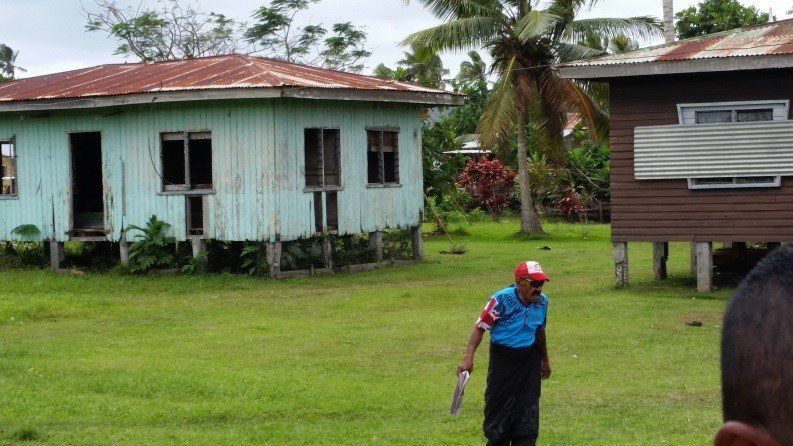
As in the churches and all the residences, we first removed our shoes and went into a room that was empty except for a woven mat on the floor. This was a meeting with the chief, to gain permission to go see the new church building.
The chief welcomed us warmly and noted Fiji Day. He was wearing a Fiji shirt and had hung a poster on the wall. He showed us a newspaper with a prayer for Fiji printed in English and in Fijian, and then specifically greeted Msgr. and me since we were visitors.
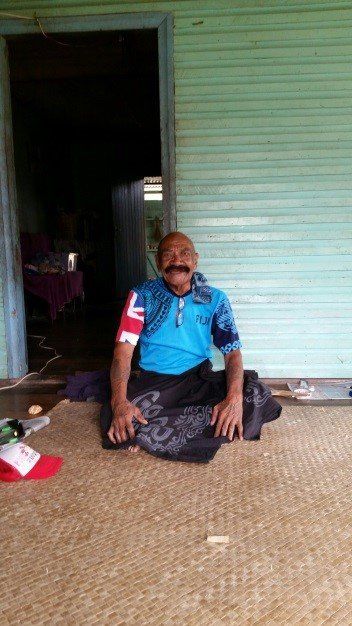
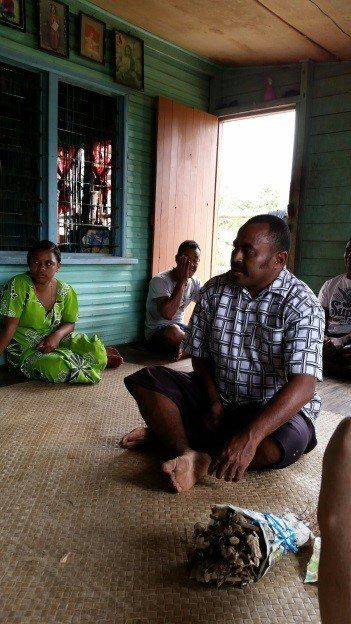
Then Wauni presented the kava to the chief. He gave a long talk in Fijian which expressed gratitude and respect for the chief and village and requested that they welcome us to the village. The chief gave and elaborate reply in which Msgr. and I could hear our names. In general he was expressing respect for Neselesele and fortunately welcoming us to the village.
As we walked over to the church, the chief said “I understand there are important elections happening in the United States.” We couldn’t get away from it even in Fiji!
The chief went on to say: “When the villagers asked me if they could build a church, I answered sure! It would bring progress to our village.”
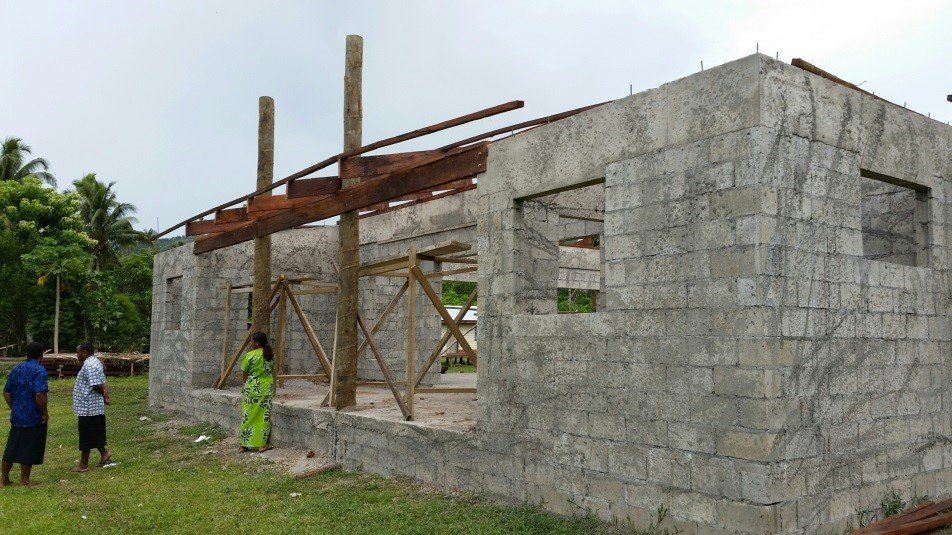
The structure is concrete block filled with concrete. The diocese of Charleston Propagation of the Faith purchased a cement mixer so they would not have to mix by hand. But they hand up buckets of concrete to workers on the top who pour the concrete into the blocks and finish the top.
The primary columns are pine and the roof structure is Vesa, a beautiful hardwood that grows in the hills nearby. Vesa looks like mahogany, but is a harder wood. The villagers use chain saws to cut and mill the wood. The trusses were beautiful. I picked up a small piece of the wood. It was quite heavy. I asked Petero how they would get the trusses up onto the roof. “By hand,” he said. “We will drill holes into the ends and fit them onto the rebar at the top.” We joked that they should have a crane. “This is our crane,” said Elia, pointed to his arm.
Msgr. Lofton expects the church to be complete in about a year and hopes to hold and opening Mass in celebration.
 Then it was time for the kava ceremony. If the village welcomes you, then they return the kava in the form of the beverage. In this ceremony the kava is served in a coconut shell in order of importance. Today, since it was my first time, I was served first. As I sat down, a many to my right, Mateo, asked “Where are you from.” Mateo is the catechist for the village. When he learned I was there to see how we can support faith formation, he said “we need you to send the pamphlets on all the subjects.”
Then it was time for the kava ceremony. If the village welcomes you, then they return the kava in the form of the beverage. In this ceremony the kava is served in a coconut shell in order of importance. Today, since it was my first time, I was served first. As I sat down, a many to my right, Mateo, asked “Where are you from.” Mateo is the catechist for the village. When he learned I was there to see how we can support faith formation, he said “we need you to send the pamphlets on all the subjects.”
Mateo had been in the meeting with the other catechists who are part of the station churches associated with Holy Cross in Wairiki, Taveuni. After the meeting I held with some of the catechists in Neselesele a few days ago, they met with all the catechists from the 10 station churches and reviewed the materials. They were particularly interested in Our Sunday Visitor pamphlets and Catholic Parent Know-How for Sacraments. Mateo went on “it is also popular to have audio and CDs for people.” I mentioned the idea of a web site and they liked that as well, since most of them have phones that can access the internet.
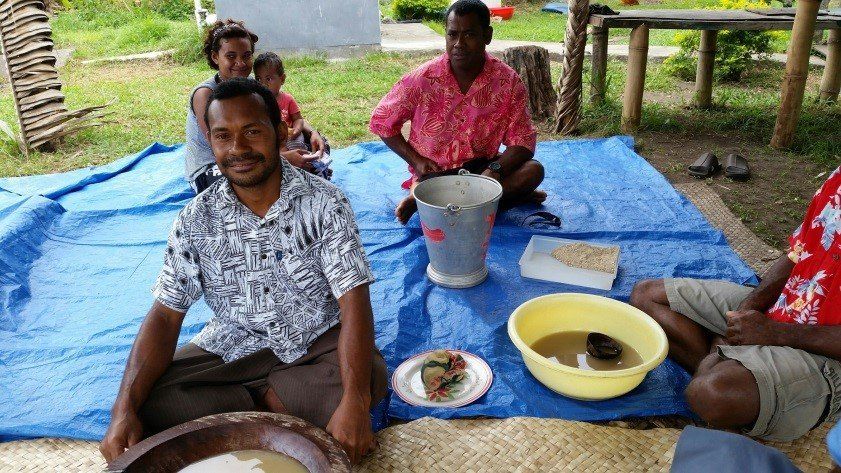
This was a surreal experience for me. The surroundings were primitive, I was in an ancient tribal ceremony, and I was talking about religious education materials and digital tools with the catechist. The assistant to catechists was serving the kava. His brother is a priest on Taveuni.
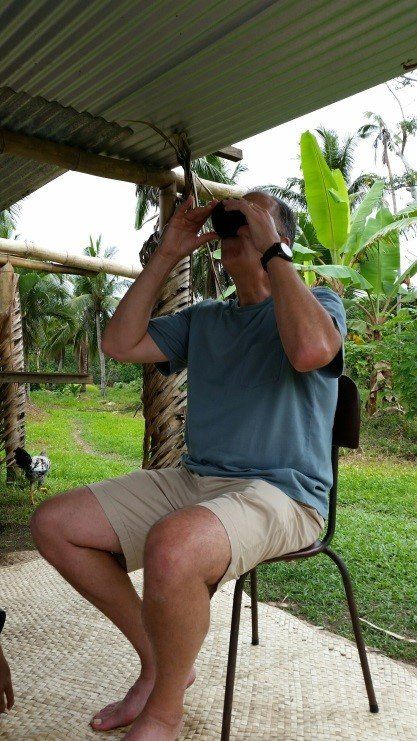 “Bula!” there was more elaborate statements of respect and gratitude from Mateo to Wauni as the kava was offered in return. And thanks back from Wauni. “Bula” then the kava was dipped into the shell and handed to me to drink down. “Vinaka” I said as I handed it back. “Thank you. Delicious! They laughed.” Then three big claps. The stuff tastes like you would expect from a ground root. You immediately feel a slight numbness in your tongue. Similar to the sensation of spraying Cepacol throat spray into your throat.
“Bula!” there was more elaborate statements of respect and gratitude from Mateo to Wauni as the kava was offered in return. And thanks back from Wauni. “Bula” then the kava was dipped into the shell and handed to me to drink down. “Vinaka” I said as I handed it back. “Thank you. Delicious! They laughed.” Then three big claps. The stuff tastes like you would expect from a ground root. You immediately feel a slight numbness in your tongue. Similar to the sensation of spraying Cepacol throat spray into your throat.
This process was followed repeatedly, first to Wauni who was leading us there, then Msgr and then the Chief. After that me and around the horn to others. Apparently if you drink enough of it you begin to feel an overall effect. I didn’t get that far.
Later on the return trip I asked Wauni what happens if the chief does not welcome you. “If he does not return kava, then you are not welcome,” he said.
“But what happens?”
“You have to leave.” I didn’t ask any further.
Mateo and the assistant catechist, whose name I didn’t get, asked us to join them to eat. One of the other standards I learned while here is that people are very hospitable and regardless of the time they ask you if they can cook and have you join them for a meal. You can’t decline
The assistant catechist lives there in the village of Nawi with his parents. He asked Msgr to bless his father and for us to join him for dinner. As we entered the house, it was similar to the chief’s. No furniture except in this case for a table and chairs with food set for us. Inside doorways had Fijian floral print fabric hung to provide some privacy.
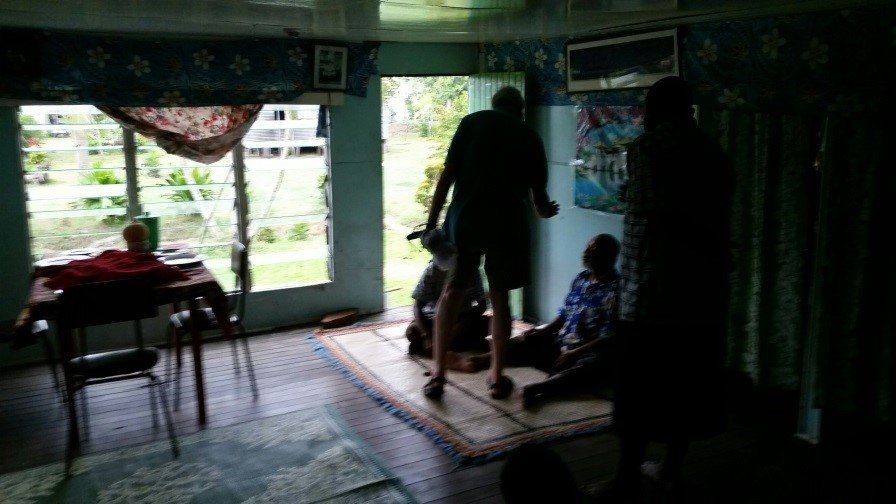
We sat down to a meal of a whole fresh fish (to be shared), caught that day in the surf. It was sitting on a type of egg and corn fritter. There were slices of breadfruit, dalo (taro root), fresh papaya, and a shredded and cooked cabbage dish that was savory. This was a special meal for us. The blessing was said after the meal by the assistant catechist.
As it was time to return home, Petero called out to us to have more kava until the boat was there for us. But the boat was ready, so Elia (the head man) and Petero walked us back to the beach.
“Do you recognize that tree?” asked Elia. I guessed a willow. “Sandalwood. The oil is in every type of perfume and is very valuable. It takes 25 years for the tree to mature enough and the oil comes from the wood of the tree trunk. It will be a future for our village.”
As we walked by a corrugated metal building, Elia said “that is our community center. We hold our meetings there.”
“How often do you meet?”
“Once a month”
“Do you have a set agenda?”
“Yes. We cover village issues and the status of money.”
As we left the shore in the boat. Elia and Petro were standing under a century-old rain tree. “Don’t forget us,” Elia said. “When you come back you can help us celebrate the new church. Don’t forget us.”
“I won’t.”
“Vinaka Vakalevu” to the amazing people in this village and all of the people I have met.
 This trip to Fiji has helped me to see the Catholic Church operating in the world. I had been to Mass in Europe, but this experience breathed new life into my own faith as I witnessed the incredible strength of the people. I have a whole new appreciation for World Missions Sunday and the importance of that national collection. And I see the ongoing need for grassroots efforts in towns and villages. The priests, catechists and school teachers welcomed the materials I brought to them from Our Sunday Visitor. They need a consistent way to teach the faith.
This trip to Fiji has helped me to see the Catholic Church operating in the world. I had been to Mass in Europe, but this experience breathed new life into my own faith as I witnessed the incredible strength of the people. I have a whole new appreciation for World Missions Sunday and the importance of that national collection. And I see the ongoing need for grassroots efforts in towns and villages. The priests, catechists and school teachers welcomed the materials I brought to them from Our Sunday Visitor. They need a consistent way to teach the faith.
I also have a renewed appreciation for community and hospitality, and the importance of these things. No matter how humble or simple, there is no substitute for a genuine welcome
Bula Vinaka!
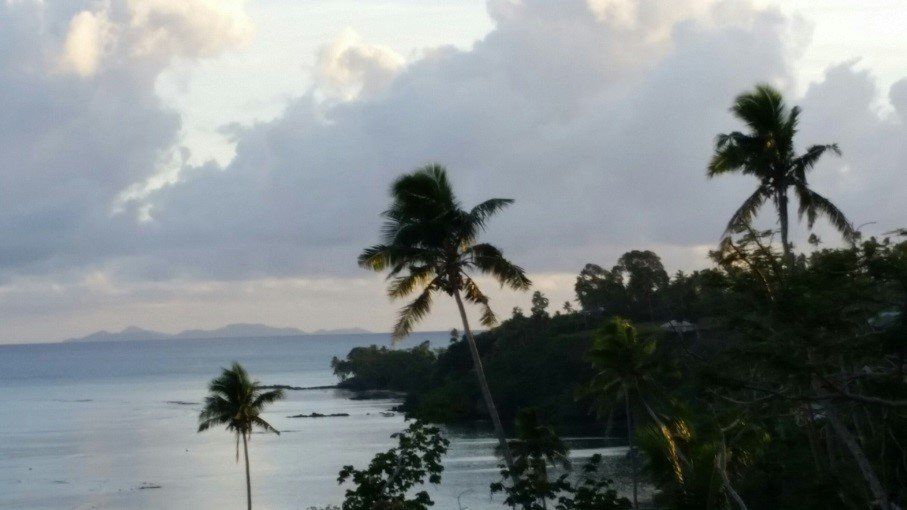
.jpg)
.jpg)
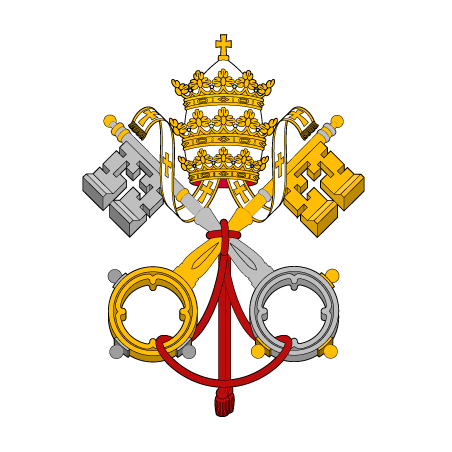
.jpg)
